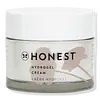What's inside
What's inside
 Key Ingredients
Key Ingredients

 Benefits
Benefits

 Ingredients Side-by-side
Ingredients Side-by-side

Water
Skin ConditioningSqualane
EmollientGlycerin
HumectantPolyglyceryl-4 Isostearate
EmulsifyingPyrus Malus Fruit Extract
Skin ConditioningCoco-Caprylate/Caprate
EmollientPropanediol
SolventDisteardimonium Hectorite
StabilisingJojoba Esters
EmollientSodium PCA
HumectantTocopherol
AntioxidantSodium Acetylated Hyaluronate
HumectantHydrolyzed Sodium Hyaluronate
Skin ConditioningTrisodium Ethylenediamine Disuccinate
Ceramide AP
Skin Conditioning1,2-Hexanediol
Skin ConditioningCaprylhydroxamic Acid
Water, Squalane, Glycerin, Polyglyceryl-4 Isostearate, Pyrus Malus Fruit Extract, Coco-Caprylate/Caprate, Propanediol, Disteardimonium Hectorite, Jojoba Esters, Sodium PCA, Tocopherol, Sodium Acetylated Hyaluronate, Hydrolyzed Sodium Hyaluronate, Trisodium Ethylenediamine Disuccinate, Ceramide AP, 1,2-Hexanediol, Caprylhydroxamic Acid
Camellia Sinensis Leaf Water
MaskingGlycerin
HumectantCaprylic/Capric Triglyceride
MaskingButylene Glycol
HumectantHydrogenated Polyisobutene
EmollientDicaprylyl Carbonate
EmollientSucrose Stearate
EmollientWater
Skin Conditioning1,2-Hexanediol
Skin ConditioningBehenyl Alcohol
EmollientGlyceryl Stearate
EmollientArginine
MaskingAcrylates/C10-30 Alkyl Acrylate Crosspolymer
Emulsion StabilisingLactobacillus/Punica Granatum Fruit Ferment Extract
Skin ConditioningCarbomer
Emulsion StabilisingBetaine
HumectantCannabis Sativa Seed Oil
EmollientPanthenol
Skin ConditioningPyrus Communis Fruit Extract
Skin ConditioningLactobacillus Ferment Lysate
Skin ConditioningAdenosine
Skin ConditioningCucumis Melo Fruit Extract
Skin ConditioningEthylhexylglycerin
Skin ConditioningPropanediol
SolventPseudoalteromonas Ferment Extract
HumectantVetiveria Zizanoides Root Oil
MaskingHedera Helix Leaf/Stem Extract
AntimicrobialDisodium EDTA
Hydrolyzed Sodium Hyaluronate
Skin ConditioningCamellia Sinensis Leaf Extract
AntimicrobialCaprylyl Glycol
EmollientSodium Hyaluronate Crosspolymer
HumectantHydrolyzed Hyaluronic Acid
HumectantSodium Hyaluronate
HumectantBeta-Glucan
Skin ConditioningHyaluronic Acid
HumectantCamellia Sinensis Leaf Water, Glycerin, Caprylic/Capric Triglyceride, Butylene Glycol, Hydrogenated Polyisobutene, Dicaprylyl Carbonate, Sucrose Stearate, Water, 1,2-Hexanediol, Behenyl Alcohol, Glyceryl Stearate, Arginine, Acrylates/C10-30 Alkyl Acrylate Crosspolymer, Lactobacillus/Punica Granatum Fruit Ferment Extract, Carbomer, Betaine, Cannabis Sativa Seed Oil, Panthenol, Pyrus Communis Fruit Extract, Lactobacillus Ferment Lysate, Adenosine, Cucumis Melo Fruit Extract, Ethylhexylglycerin, Propanediol, Pseudoalteromonas Ferment Extract, Vetiveria Zizanoides Root Oil, Hedera Helix Leaf/Stem Extract, Disodium EDTA, Hydrolyzed Sodium Hyaluronate, Camellia Sinensis Leaf Extract, Caprylyl Glycol, Sodium Hyaluronate Crosspolymer, Hydrolyzed Hyaluronic Acid, Sodium Hyaluronate, Beta-Glucan, Hyaluronic Acid
 Reviews
Reviews

Ingredients Explained
These ingredients are found in both products.
Ingredients higher up in an ingredient list are typically present in a larger amount.
1,2-Hexanediol is a synthetic liquid and another multi-functional powerhouse.
It is a:
- Humectant, drawing moisture into the skin
- Emollient, helping to soften skin
- Solvent, dispersing and stabilizing formulas
- Preservative booster, enhancing the antimicrobial activity of other preservatives
Glycerin is already naturally found in your skin. It helps moisturize and protect your skin.
A study from 2016 found glycerin to be more effective as a humectant than AHAs and hyaluronic acid.
As a humectant, it helps the skin stay hydrated by pulling moisture to your skin. The low molecular weight of glycerin allows it to pull moisture into the deeper layers of your skin.
Hydrated skin improves your skin barrier; Your skin barrier helps protect against irritants and bacteria.
Glycerin has also been found to have antimicrobial and antiviral properties. Due to these properties, glycerin is often used in wound and burn treatments.
In cosmetics, glycerin is usually derived from plants such as soybean or palm. However, it can also be sourced from animals, such as tallow or animal fat.
This ingredient is organic, colorless, odorless, and non-toxic.
Glycerin is the name for this ingredient in American English. British English uses Glycerol/Glycerine.
Learn more about GlycerinThis ingredient is created by putting sodium hyaluronate through hydrolysis.
You might know this as 'mini' or 'ultra low-molecular weight' hyaluronic acid. The small molecule size means it is able to travel deeper in the skin.
According to studies, low molecular-weight hyaluronic acid can:
One study from 2011 found ultra-low weight HA to show pro-inflammatory properties. Another study from 2022 found it to downregulate UV-B induced inflammation.
Hydrolysis is a process of changing a molecule using water or enzymes.
This ingredient is water-soluble.
Learn more about Hydrolyzed Sodium HyaluronatePropanediol is an all-star ingredient. It softens, hydrates, and smooths the skin.
It’s often used to:
Propanediol is not likely to cause sensitivity and considered safe to use. It is derived from corn or petroleum with a clear color and no scent.
Learn more about PropanediolWater. It's the most common cosmetic ingredient of all. You'll usually see it at the top of ingredient lists, meaning that it makes up the largest part of the product.
So why is it so popular? Water most often acts as a solvent - this means that it helps dissolve other ingredients into the formulation.
You'll also recognize water as that liquid we all need to stay alive. If you see this, drink a glass of water. Stay hydrated!
Learn more about Water